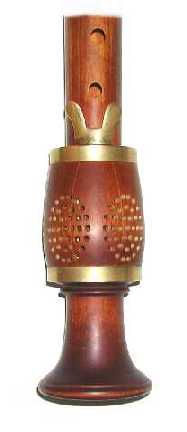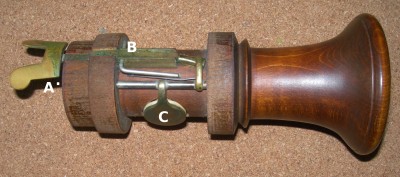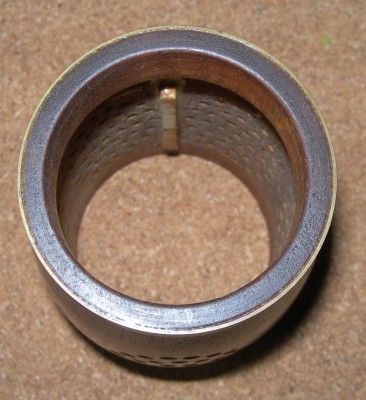Fontanelle Foot Joints

Hopf tenor foot,with
fontanelle and butterfly key.

Moeck renaissance bass,
fontanelle and butterfly key.
The mechanism under the Fontanelle
(See further down for comments on removing a fontanelle.)

Stiff and sluggish action of the key is a common problem.
It is generally caused by corrosion and thickening
of the lubricant. Care must be taken not to allow a
hardening oil like linseed to contaminate the moving parts.
Both major moving parts are prone to stick.
The easy one to correct is the key lever that runs in a channel and pivots on the 'L' shaped rod at 'B'. The rod can be removed without tools. The channel, lever and bearing surfaces can be polished with steel wool and lubricated with light non-gummy oil. (I use gun oil.)
The key cup 'C' pivots on a long axle from 'A' which extends into a blind hole in the lower of the two bands around the foot joint.
The end of the axle is usually flush to the top of the foot joint at the 'A spot' and there is no access to push it out from the other end. With a bit of luck it can be persuaded to jump out of the hole if the foot joint is held loosely and given a sharp downwards blow with a mallet. If you have to hit it really hard it is best to make a round, stepped, block to fit the socket and save the joint itself from being damaged by the impact of the mallet. Another approach is to pick it out of the hole, with a sharp steel blade, just far enough for it to be gripped by a pair of pliers, held sideways on. (Do not use cutters except with great care. The rod is not ferrous metal and you may accidentally cut the end off!)
Note the way that the spring is lodged behind a screw. When the axle has been drawn out the key becomes free and may jump out of its original position. The axle and the tube that runs on it can be cleaned and lubricated. The key cup should be able to rotate freely under its own weight.
Removing a fontanelle.
There are several variations of fontanelle fitting but they all come off upwards, over the butterfly key, which may have to be depressed out of the way. Examine the brass rings carefully for a possible fixing peg or screw. If one is present it must be removed. The Hopf fontanelle illustrated below has a very cunning device to stop it coming off accidentally.

There is a key way slot in the upper band, opposite the butterfly key, to accomodate the key glued to the inside of the fontanelle. Assembly is obvious, push the parts together and then rotate the fontanelle. Dis-assembly is rather more a matter of trial, error and frustration, especially if the parts are stiff.
Fontanelles usually are stiff. The thin wood warps and shrinks with age. Take great care and also look out for parts of the key or the 'L' shaped pivot moving so as to impede the progress of the fontanelle, in either direction.